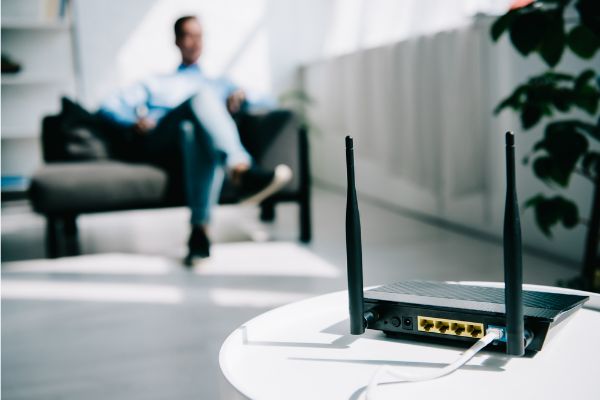Disclaimer: This post may contain affiliate links, meaning we get a small commission if you make a purchase through our links, at no cost to you. For more information, please visit our Disclaimer Page.
Netgear began in 1996, and it has evolved over the decades to become an international computer networking organization. It features offices in several countries around the globe, and it provides many types of hardware that both businesses and individuals might use for their technological needs.
One of the common products that Netgear develops is its own line of routers. Routers take the signal from your internet service provider and make sure that it is distributed around your home or office to ensure greater connectivity. You can use routers to have several devices connected to a Wi-Fi network at once.
In order to facilitate all of this, many routers will need periodic updates. There may be times when some users find themselves unable to update their Netgear routers on their own. In our article, we will go over some of the common factors that might be interfering with your ability to update your router from Netgear.
Additionally, we will cover topics surrounding whether you should always update your router, why it might stop working after one of the many updates, how often the device might need updates, and if you can set it to download such updates by itself.
Table of Contents
Why Should I Update My Netgear Router?
There are three main reasons why you should consider updating your Netgear router to its latest version. The first has to do with performance. Netgear puts out updates to its routers that are designed to enhance how it functions.
This may be something noticeable, like better speed for your internet connection. In some cases, the router may slow the speed somehow. A firmware update is software that tells the unit how to operate. This means that keeping it at its most current version might mean that it has newer software to work with in order to enhance its performance. There could be other fixes in this category that you don’t notice in your daily operations, but they are still important.
Secondly, updates to routers can address glitches. If your Netgear router is behaving erratically, an update to its firmware could solve the issue. This behavior might come in the form of intermittent connection drops, slower speeds, bizarre protocols, things changing without your knowledge, and more.
When a company is aware of such problems, providing a firmware update is one of the most expedient ways to solve them. In fact, new versions of some firmware for routers might contain bugs of their own that the development team didn’t pick up on before rolling things out. In these cases, a new firmware update that corrects these errors may replace one you just got not long ago.
Finally, security is a major concern with routers. Any tech that allows you access to the internet must both send and receive information. This means that your network or systems have to be somewhat open. While this is necessary, it also means that your home or business, as well as the data you send through it, could be vulnerable to some kind of attack from malicious actors.
Companies that make and sell products like routers look for security issues on an almost constant basis. One of the easiest ways to make sure all of their customers have routers that are as secure as possible is to release firmware updates that you can download and install.
Why Can’t I Update My Netgear Router?
You may experience some issues when you try to update your Netgear router. The precise problems you encounter might vary from one model to the next, but most of Netgear’s products should display similar errors.
However, it is possible that you’re trying to update your router with no error message appearing at all. In such cases, the update will simply fail. In others, it may look like it completed the update, offer no error message, but still change nothing. You can check if this is the case by looking at the firmware version number prior to trying for the update.
To locate the firmware number, as well as other settings that you may need to access in order to facilitate the update, you can go to a web-based portal that takes you inside your router.
There may also be an app for your mobile devices that will let you look at the router’s settings. For this app, you might be restricted to some of the more basic operations you can perform on the router. Advanced setting changes usually require you to access the full web portal using the security protocols you set when you first activated your Netgear router.
If you try to perform an update on your Netgear device, the firmware number that appears afterward can indicate whether the update failed. If it did, you may need to troubleshoot a few solutions before you can get the update to succeed.
Having said that, it is worth mentioning that the firmware could have updated without the number itself changing. This would be a rare occurrence, but it is possible that the company created a recent firmware update that does what it is supposed to do, but they did not change the number of the firmware to reflect its new status.
The only way you might test if this numbering problem is an issue would be to downgrade your firmware version manually. You can follow these steps to troubleshoot this possibility:
1. Download a firmware version for your router model from Netgear’s website. Make sure it is a previous version from the one you are running now.
2. Install the previous version of the firmware you downloaded. Confirm that the firmware number did change to a lower value.
3. Go back to the site and download the most current version of the firmware available for your router. This would be what you are trying to update the router to automatically.
4. Install the latest firmware, and take note of the number it changes to once more.
5. If this number is still the same as the original one you had before you downgraded, it is likely that you have the latest firmware under an old number.
6. Check to make sure there are no error or failure messages after installing the latest version of the Netgear router model’s firmware.
How Come Netgear Router Stopped Working After Firmware Update?
If your router from Netgear seemed to be working fine until the most recent update, it is possible that the firmware is to blame. As we mentioned, some versions of new releases can have bugs that aren’t accounted for before they go out to consumers.
If this is the case, it could be that the update itself is problematic, and the software involved has given some improper instructions to the router on how it should operate. This could cause it to stop functioning altogether.
Otherwise, it is possible that there was some kind of interruption during the update process itself. If this happens, the firmware could fail in such a way that the router is now operating with incomplete pieces of instructions.
Trying to function in this way could cause the device to not know what to do, and it would stop working efficiently as a result. You may get error messages that let you know if an update was interrupted somehow, but this is not necessarily a foregone conclusion.
If possible, check to see what the firmware number is after the update, and you can compare it to the one you know you had before. Similarly, look for lights on the router that may indicate a problem.
How Can I Fix This?
The first thing you can try to do to fix a Netgear router that isn’t functioning after an update is just to reset it. You can try the soft kind of reset first. This would involve turning off the router for at least 30 seconds before turning it back on again.
You could also try unplugging it for the same length of time in order to let the charge inside the device dissipate. Additionally, you could do the same with your modem at this time, but it isn’t a requirement. Once you plug things back in, you can check your router’s lights and your internet connection speed or access to see if it all works again.
If none of that works, a hard reset that puts the router back to factory settings might be necessary, too. You can do this by finding the appropriate reset port on your router. In most cases, you can insert a small object and hold it there until all the lights on the router start to flash.
This should indicate that the whole thing has undergone a reset. From there, you can set up your router and network again. You may wish to go for a slightly older firmware release, but you can try the newest one again to see if it goes through.
Do Netgear Routers Automatically Update?
Some routers from Netgear may support automatic updates. However, you may need to find updates manually for some of the company’s products.
In many cases, Netgear tries to notify users when a new update is available. Once you access your router’s settings, you can look for any menus related to ‘Advanced’ operations or ‘Updates’ to see if there are options to have yours do so automatically.
How Often Does Netgear Update Firmware?
Netgear releases updates or hotfixes to address particular issues whenever they are discovered. However, with consumer-grade routers, there is not typically a set release schedule for regular updates to the firmware.
Conclusion
Routers from Netgear are a good choice for getting internet access from a company that has many years in the business. However, no product is immune to certain bugs or problems. Firmware updates are a convenient way to address these issues, but you may need to do some troubleshooting of your own to get them to work properly.


